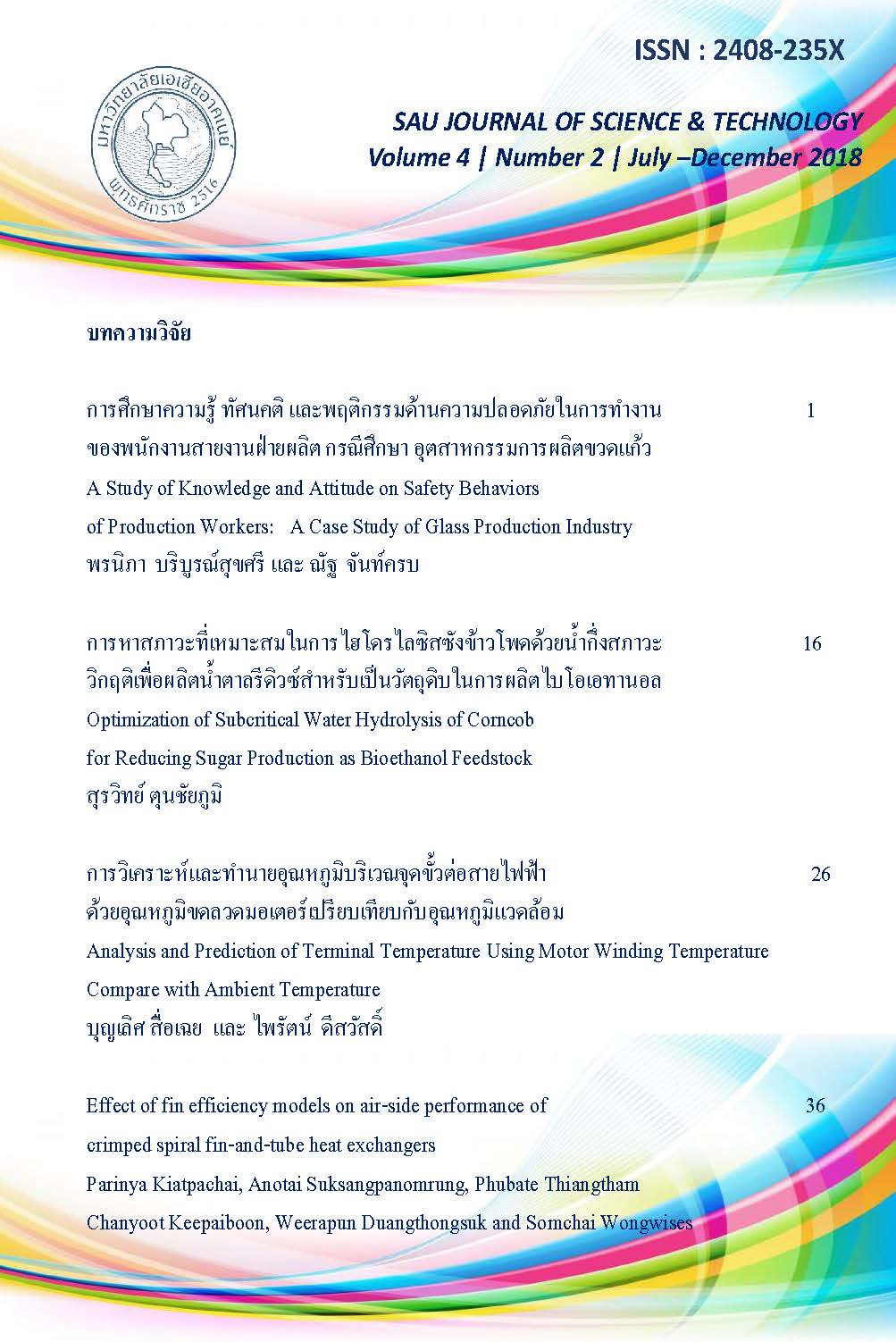Optimization of Subcritical Water Hydrolysis of Corncob for Reducing Sugar Production as Bioethanol Feedstock
Main Article Content
Abstract
Corncob is one of the Thai agricultural residues which are classified as lignocellulosic material, it can be converted to reducing sugar as bioethanol feedstock. The purpose of this research was the optimization of reducing sugar production form corncob using subcritical water (SCW) hydrolysis. Response surface methodology (RSM) with box-behnken design was employed to optimize hydrolysis conditions: temperature (170-210 oC), time (30-90 min) and raw material to water ratio (R/W ratio)(1:10-1:30). The RSM results indicated that SCW hydrolysis conditions (temperature, time and R/W ratio) could significantly affect reducing sugar yield (P<0.05), the optimization of SCW hydrolysis conditions were as follows: 193 oC, 44 minutes and R/W ratio as 1:30, which gave the highest reducing sugar yield of 32.54% g/g dried raw material. Moreover, the SCW hydrolysis gave amount of reducing sugar which was higher than using acid hydrolysis at time of 60 min as 1.4 times.
Article Details
References
2. J.S. Van Dyk and B.I. Pletschke, A review of lignocellulose bioconversion using enzymatic hydrolysis and synergistic cooperation between enzyme-Factors affecting enzyme, conversion and synergy, Biotechnology Advances, vol. 30, pp. 1458-1480, 2012.
3. Office of Agricultural Economics. (2018, May. 9). “Agricultural Productivity” [Online]. Available: https://oae.go.th
4. R.L. Howard, E. Abotsi, E.L. Jansen Van Rensburg and S. Howard, Lignocellulose biotechnology: issue of bioconversion and enzyme production, African Journal of Biotechnology, vol. 2, no. 12, pp. 602-619, 2003.
5. C. Niwaswong and C. Ruangviriyachai, Production of Cellulosic Ethanol in Thailand, KKU Science Journal, vol. 40, no. 4, pp. 1073-1088, 2012 (in Thai).
6. N. Klaichom, P. Srinophakun and A. Thanapimmetha, Reducing Sugar Production from Sweet Sorghum Bagasse by Acid Hydrolysis, Kasetsart Engineering Journal, vol. 24, no. 75, pp. 91-102, 2011 (in Thai).
7. S. Chongkhong and C. Tongurai, Optimization of glucose production from corncob by microwave-assisted alkali pretreatment and acid hydrolysis, Songklanakarin Journal of Science and Technology, vol. 40, no. 3, pp. 555-562, 2018.
8. J.M. Prado, L.P. Daniel, T. Forster-Carneiro and M.A. Rostagno, Sub-and supercritical water hydrolysis of agricultural and food industry residues for the production of fermentable sugars: A review, Food and Bioproducts Processing, vol 98, pp. 95-123, 2016.
9. L. Richen, J. Cheng, L. Ding, W. Song, F. Qi, J. Zhou, K. Cen, Subcritical water hydrolysis of rice straw for reducing sugar production with focus on degradation by-products and kinetic analysis, Bioresource Technology, vol. 186, pp. 8-14, 2015.
10. A. Shitu, S. Izhar and T.M. Tahir, Subcritical water as a green solvent for production of valuable materials from agricultural waste biomass: A review of recent, Global Journal Environment Science Management, vol. 1, no. 3, pp. 255-264, 2015.
11. S. Sunphorka, W. Chavasiri, Y. Oshima, S. Ngamprasertsith. Protein and sugar extraction from rice bran and de-oiled bran using subcritical water in a semi-continuous reactor: Optimization by response surface methodology, International Journal of Food Engineering, vol. 8, no. 3, 2012.
12. W. Abdelmoez, A.M. Nage, A. Bastawess, A. Ihab and H. Yoshida, Subcritical water technology for wheat straw hydrolysis to produce value added products, Journal of Cleaner Production, vol. 70, pp. 68-77, 2014.
13. M.A. Rostagno, J.M. Prado, R. Vardanega, T. Forster-Carneiro, M.A.A. Meireles, Study of Recovery of Fermentation Sugars with Subcritical water and Carbon Dioxide from Palm Fiber and Grape. Chemical Engineering Transactions, vol. 37, pp. 403-408, 2014.
14. G.L. Miller, Use of dinitrosalicylic acid reagent for determination of reducing sugar, Analytical Chemistry, vol. 31, pp. 426-428. 1959.
15. G. Zhu, Z. Xiao, X. Zhu, F. Yi and X. Wan, Reducing sugar production from sugarcane bagasse wastes by hydrolysis in sub-critical water, Clean Technology Environment, vol. 15, pp. 55-61, 2013.
16. D. Lachos-Perez, F. Martinez-Jimenez, C.A. Rezende, G. Tompsett and M. Timko, T. Forster-Carneiro, Subcritical water hydrolysis of sugarcane bagasse: An approach on solid residues characterization, The Journal of Supercritical Fluids, vol. 108, pp. 69-78, 2016.


